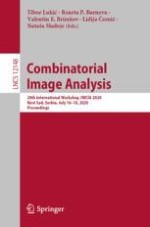This book constitutes the refereed proceedings of the 20th International Workshop on Combinatorial Image Analysis, IWCIA 2020, held in Novi Sad, Serbia, in July 2020.
The 20 full papers presented were carefully reviewed and selected from 23 submissions. The papers are grouped into two sections. The first one includes twelve papers devoted to theoretical foundations of combinatorial image analysis, including digital geometry and topology, array grammars, picture languages, digital tomography, and other technical tools for image analysis. The second part includes eight papers presenting application-driven research on topics such as image repairing, annotation of images, image reconstruction, forgery detection, and dealing with noise in images.
